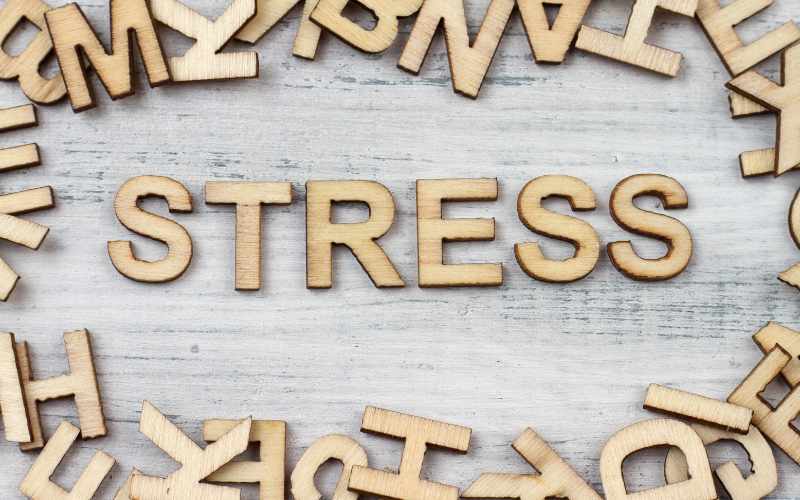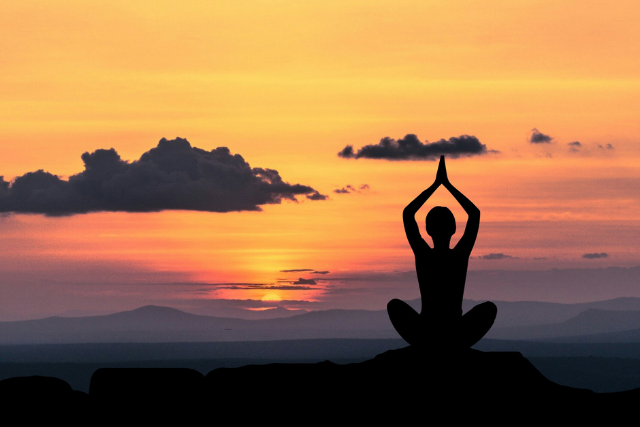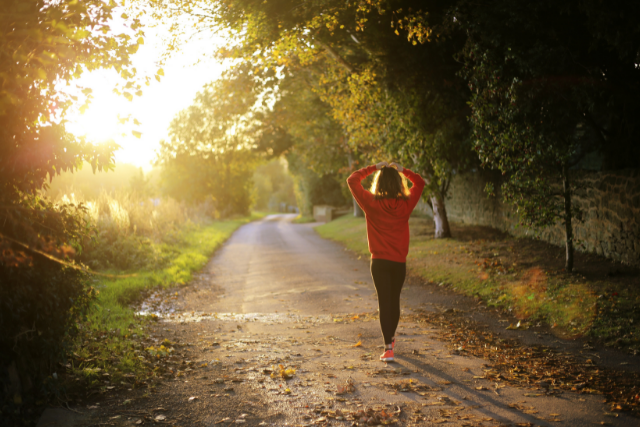8 Exercises to Keep Stress at Bay

Do I have a profound hatred for waking up early in the morning? Yes. Do I have insurmountable amounts of stress? Also, yes. Has waking up early to do some of these stress-management exercises helped my grumpy self? Also, also yes.
Okay, let’s be honest. Stress in our lives is like that villain everyone dislikes, it has no redemption. The worst part about being under the duress of stress (see what I did there?) is the fact that stress is not a visible phenomenon. Sure, it has many different kinds of physical manifestations but it can be challenging for people to identify you’re stressed. And that can add a lot more stress on your plate (which to be fair, is no parmesan so you must learn to say ‘when’).
More often than not, we tend to ignore stress like the plague. And when it becomes unbearable, we run to our doctors. Now, don’t get me wrong, the medicines they prescribe sure do work, a lot better than bottling all that stress up! But does them being effective mean that they’re also safe for continuous consumption? After all, these are small pills of chemicals and minerals that are supposed to help you in a pinch, not become regular to the point where you’re dependent on them. In the longer run, exercising is the healthiest and most practical way of reducing and managing your everyday stress.
If you’re unable to eliminate your stressors (like when your neighbors just won’t stop being loud), the next best thing to do is to manage them (a good dummy-punching session may do the trick!). Here are some tried and tested exercises that are great stress busters:
Mindful Meditation
For decades, the simple practice of meditation has been overcomplicated to the point where the thought of meditating or being asked to meditate would give me more stress than meditation itself would relieve. I remember despising the meditation periods back in middle school. It just seemed so redundant to me. However, a while back, during one intensely stressful week of assignment submissions, I decided to give a try to the most basic meditation technique I could find. I willed myself to repeat it at least once a day for a few minutes for the next 2-3 days and it finally started to make sense. Here’s what I followed: –
- Try to eliminate all controllable disturbances from your surroundings.
- Sit cross-legged on the ground and get comfortable.
- Close your eyes and focus on your breathing.
- Keep doing so for a short period.
- Then open your eyes and slowly divide your focus between the things you see and the sounds you hear.
- Repeat a few more times. This meditation can be done anywhere from 5 minutes to half an hour, once a day.


Yoga
We’ve been taught about the wonders of ‘yog’ or “yoga” (as the West likes to call it) ever since we were literal children. There would be these yoga camps all through May and June during my summer vacations. I think it’s ironic how tranquil times were back then. While there may not be any correlation between the yoga camps and the lack of stress in my life back then, yog surely is a source of comfort now. Just like all other good things in life, one must learn to be consistent with stress-management exercises. There are many yogic practices and asanas one can choose to follow but personally, early morning Surya Namaskar (Sun Salutations) (consisting of 12 poses) have been the most effective in preparing me for the “upcoming” stressors in my day. Here’s how to perform Surya Namaskar: –
- Layout your yoga mat on the floor and stand at its edge.
- Pranamasana: Balancing your weight equally on both feet, keep your heels together and slightly open your toes so that they move away from each other. Take your shoulders back and relax so that your chest expands. Breathe in while lifting your arms. Then exhale while bringing the palms together in front of your chest as if you were praying.
- Hastauttanasana: While breathing in, lift your arms from the front and pull them back over your head. Ensure that your biceps are close to your ears. From this position, push out your pelvis a tad and attempt to pull your entire body up and back without bending your legs and keeping them firmly placed on the ground.
- Hastapadasana: Bend forward (while breathing out) from the waist and ensure that the spine remains erect. Slowly bring your hands to the floor beside your feet as you finish exhaling.
- Ashwa Sanchalanasana: Push your right leg (whilst breathing in) as far back as possible. Touch your right knee to the floor and look towards the sky, as you breathe out.
- Dandasana: Breathe in while taking the left leg back so as to bring your entire body in a straight line.
- Ashtanga Namaskara: Touch both your knees to the ground and exhale. Raise your hips from the back and touch both your chest as well chin to the ground.
- Bhujangasana: Slide forward whilst breathing in and raise your chest so as to resemble a cobra. Keep your shoulders away from your ears and your arms slightly bent and look up.
- Adho Mukha Swanasana: Breathing in, reinforce the grip of your hands and feet on the ground, then lift your buttocks and spine to bring your body into the inverted shape of the alphabet ‘V’.
- Repeat poses 4 (Ashwa Sanchalanasana), 3 (Hastapadasana), and 2 (Hastauttanasana).
- Tadasana: Straighten your body while exhaling, followed by bringing your arms down. Then relax in this position and observe the sensations in your body.
- This salutation can be repeated up to 108 times in one go (which burns 1500 calories approximately). However, it is recommended that you start slowly from 5-10 salutations.
Stretching
Light stretching exercises as a way of dealing with stress are probably the easiest stress-buster in the entirety of this guide. Stretching is my go-to exercise when I’m overwhelmed with work, have to finish 20 different tasks, and have no time to spare. Stretching can keep you going for a lot longer than you actually would without any means of management while still being able to finish work (a total win-win). It is quick, effective, efficient, and requires little to no space. I’ve actually already done it once while writing this blog! Here’s what I like to do: –


- Stretching your back: Stand up straight wherever you like. Raise your arms straight above your head and interlock them. Whilst keeping them straight, bend sideways to the left from the waist. Go as far down as possible while ensuring your body faces the same way. Do not bend your legs. Repeat the same motion for the right side, forward as well as backward.
- Stretching your shoulders: Stand up straight and relax. Curl up your right arm and grab its elbow from your left arm. Pull the elbow towards the left as you straighten out your right arm in the same direction. Hold for a few seconds and release. Repeat with the other hand.
Running
Running as a stress-buster is not for the weak-legged folks. It takes up a lot of energy to make a habit out of running (I still struggle with it!) but once you get the hang of it, it can be really rewarding to run long distances to clear your headspace. The increased physical activity certainly does great things for your health but it also doubles as an effective tool when dealing with high amounts of stress.
There isn’t much of a technique to running but here are a few things you can do to make the most of the experience and enhance it as your stress-management exercise: –
- Invest in good, concern-specific shoes. Running is a high-intensity workout and exerts a lot of pressure on your feet. To ensure that you don’t end up writhing in pain after every run, invest in shoes specifically engineered for running and pick and fit and size and appropriate for you.
- Run while listening to music. Music can do so many different things for us. It can motivate you while also giving you tranquillity. Listening to music while running can be a fun experience and the perfect stress buster as it engages your mind and gives it something to pay attention to so that you don’t tire sooner than your real potential.
- Run in empty spaces. Running takes space because of the sheer speed someone is at. Hence, running in crowded places is as good as not running at all. So, to avoid bumping into people and other objects, choose an open space for running. This can be conducive to the purpose as you will be less likely to feel irritable and will find it easier to cause a drop in your stress levels.
- Run either in the morning or at night. Running early in the morning or a little later in the night are both good options for people who want to run and avoid the sensory overload of interacting with others. When there aren’t many people or cars or other noise-causing agents, it is easier for an individual to feel at peace. This should, however, only be done when you have appropriate means of self-defense.
Brisk Walking
If you’re someone whose stamina is as bad as mine, you’re probably not the best at running. And while running is a great stress-relieving exercise, it should not come at the cost of you heaving and gasping for breath on the side of the road. A better alternative for you (and me) would be to try brisk walking. The benefits of brisk walking are the same as running, only it doesn’t tire you half as much! Brisk walking is essentially walking faster than you normally would. A good way to find out if you’re actually brisk walking would be to check your speed and step count. The average brisk walking speed is approximately 4.5 miles per hour. It can also be measured as about 100 steps in a minute.


And while there’s not a lot of “technique” involved in walking, here are a few things you can do to maximize its benefits and make it more effective as a stress-buster: –
- Wear good quality walking shoes. Similar to running, the purpose of walking also has shoes specifically engineered for it. These are the shoes that should be worn when one goes on long walks and is regular for brisk walking.
- Find a walking partner. Walking alone for the sake of walking can feel boring and redundant. Finding a partner to walk with can make the activity of walking itself a lot more exciting. It can even make one look forward to walking because of the association it has. Having a partner also keeps you motivated and in check.
- Walk in gardens and parks. The visuals of your surroundings are more important than you think. Brisk walking in a scenic park or a lush garden is likely to relieve you of your stress a lot more effectively as compared to doing the same in a random street or on the side of the road.
- Walk twice a day. As we’ve already established, brisk walking and running are very similar. However, the arena wherein they differ, is their intensity. Walking twice a day can give you similar results to running once a day.
Dancing
You know those great dancers who can dance effortlessly, anywhere, without choreography and enjoy dancing in public a lot? Yeah, I’m not one of them. In fact, I’m nowhere even close. Dancing when you have an audience can be nerve-wracking and that’s like stress’ annoying cousin, she just can’t sit with us (mean girls reference!). But, that’s the beauty of dancing. It doesn’t have to be rhythmic or well-choreographed or graceful or anything else! So long as it makes you feel good and is able to relieve some of your stress, it works great!
There is no specific recipe when it comes to dancing to relieve stress, especially when you’re just starting out but here are a few tips that may help.
- Start freestyling your own way and follow choreographies later. If you’re new at dancing and have no sense of rhythm (personally guilty!), attempting to follow someone else’s choreography and not being able to do so properly can make you conscious of your skills, or lack thereof and in turn, can end up making you more stressed than when you began!
- Always play the music you’re fond of. When you’re only starting to experiment with dancing, playing the music you already like is the safe choice to make. This is not the time to be adventurous but rather to explore yourself. The focus should be on bidding farewell to the stress you’ve been holding rather than focusing on the musical elements.
- Do it alone. When you want to dance for yourself, you should dance by yourself. Someone else’s presence when you’re dancing your stress can be a daunting experience. It can take away the focus from dancing to feel better, to dancing to look better.
Boxing
I’ve already mentioned that punching dummies when your neighbours are being too loud works wonders. You can take a similar but more refined approach and choose boxing as a hobby or perhaps even as a sport!
People have two primary types of responses when they’re stressed. They either break down and cry, which is completely normal and healthy, or they possess aggressive tendencies which can also be healthily expressed if dealt with carefully. One such way is to pick up a sport like boxing.
Things to keep in mind when trying to box as a beginner: –
- Do not box with people without proper training. While boxing a punching bag is a fun outlet for your stress to dissipate, doing so with actual people can be harmful and problematic for both parties involved.
- Avoid boxing for sport. Since the purpose here is to deal with stress effectively, it can be served with a few practice sessions here and there. Making a boxing career out of it is likely to be more stress-inducing than the activity is stress-relieving.
- Wear appropriate safety gear. An injury caused by the lack of proper safety gear is bound to double up as a stressor and in turn, do more harm than good.


Tai Chi
I’ll be honest, I hadn’t even heard of this exercise to deal with stress up until now. I watched one video on the complete art and workout and safe to say, I am sold! Tai Chi is a gentle practice that matches slow and deliberate movements with breathing exercises. It originates from an ancient chinese tradition and is practiced as a graceful form of exercise in this day and age. It comprises a non-competitive, self-paced system wherein there exists a seamless flow of one posture to another, which ensures that your body is constantly in motion.
Tai Chi can be performed by people of all ages and fitness levels as it puts minimal stress on muscles and is generally low-impact. It can be done anywhere, indoors or outdoors, and is extremely cost-effective as it requires little to no equipment.
The perfect way to go about learning and performing Tai Chi is either through watching videos online or hiring a trainer.
Bottom Line
Stress is a common phenomenon shared by humans everywhere alike. The way the world has progressed, our lives have been burdened with sensory overload. It can be difficult to understand how to deal with said phenomenon and is confusing to think why these exercises and techniques are not more spoken about. One may feel overwhelmed to think about the adverse effects stress can have on their body and mind and how good or harmful stress medication is for them, but with the aforementioned exercises, the process becomes infinitesimally easier.









